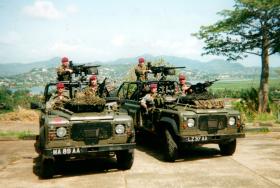In imagery of airborne forces vehicles in the Second World War it is apparent a similar camouflage pattern is employed on each. The basis for the camouflage pattern painting of military equipment is contained within Military Training Pamphlet (MTP) No 46, Part 4A: Painting of Mechanical Transport.
This pamphlet, issued on 27 November 1941 contained guidance notes on the problems and basic principles of camouflage pattern painting of vehicles and was issued army wide. It focussed on the observation of equipment from the air and how to counter act the upper surfaces reflecting light and the shadows contained or cast by a vehicle.
To this end, the vehicle was to be painted a basic camouflage colour, either Khaki Green G3 or Standard Camouflage Colour (SCC) No 2 Brown. G3, however, was rapidly replaced by SCC No 2 as stocks of Chromium Oxide required to make the Khaki Green paint became scarce. The upper surfaces were then to be painted SCC No 1A Dark Brown to mitigate light reflection from above.
A series of ragged edges were then applied to break up the demarcation between the dark topsides and basic coloured sides. The shadows on the lower half of the vehicle were then extended and absorbed by the addition of SCC No 1A, again with a ragged edge.
This produced vehicles with a distinctive camouflage pattern, based on 3 authorised variations:
1. Foliage Pattern: A series of vegetation shaped lobes forming the ragged edge.
2. Dappled Pattern: A series of blobs forming the ragged edges.
3. Dry Brush Pattern: A series of dry brushed marks to form the ragged edge.
In practice the 'Dappled Pattern' became predominant and morphed into a series of interconnected circles which became known as the 'Mickey Mouse Ear' scheme, due to its similarity to the famous rodent's head!
This resulted in a number of stylised designs and Camouflage Chart No 15 was issued in May 1943 to again standardise the pattern painting. It provided a series of colour images demonstrating an officially authorised pattern similar to the 'Foliage Pattern'. Previous designs, particularly the 'Mickey Mouse Ear' were hence forth forbidden. Chart No 15 also noted that SCC No 14 Black was to become the dark paint used, replacing SCC No 1A.
Equipment supplied from the United States was left in US Olive Drab coloured paint until repainting became necessary.
This resulted in the airborne forces, during the period 1941 -1943, using Olive Drab Jeeps (with or without SCC No. 1a/SCC No. 14 MTP 46/4A patterns), or repainted Jeeps in SCC No 2/SCC No 1A or SCC No 14 in MTP46/4A schemes and Tetrarch light tanks in SCC No 2/SCC No 14 MTP46/4A schemes.
To produce uniformity, and to avoid repainting of US supplied vehicles, a British version of Olive Drab, SCC No 15, was introduced in the spring of 1944 as the basic colour, replacing SCC No 2. Initially, it was only to be used when repainting became necessary.
This resulted in many vehicles, including Tetrarch Tanks, dropping into Normandy in the MTP46/4A schemes using the earlier SCC No 2 and SCC No 14/1A combination of colours.
Some vehicles may have had the SCC No 2 basic shade over painted with SCC No 15, although this practice was stopped in August 1944 when MTP46/4A was withdrawn and pattern painting abandoned to be replaced with overall SCC No 15 Olive Drab vehicles.
As a consequence generally all the airborne forces vehicles, such as Jeeps, used on Operation Market Garden were a uniform single colour of either British or American Olive Drab, but with a large amount of ancilliary equipment, such as trailers, still in SCC2 and SCC14 disruptive patterns.
Post war British Standard Colour (BSC) 224 Deep Bronze Green, in a gloss finish, became the standard colour of all British equipment. For operations in the Middle East BSC 361 Light Stone with black disruptive stripes was utilised. In the late 1960s, BSC 285 NATO Green was introduced for all vehicles and this could commonly be seen over striped with black for camouflage.
Whilst on operations with the United Nations vehicles are repainted overall white.
For Operations Telic and Herrick in the early 2000s, BSC 361 Light Stone was again utilised, although some units, notably the Pathfinders, utilised BSC 380 Desert Sand, a distinctly pink shade on their vehicles.
For later tours of Afghanistan some vehicles were repainted in an "Army Brown" light tan shade rather than Light Stone, specifically developed to better blend with the Afghan environment.
Source:
Airborne Assault Archive
Read More















Latest Comments
There are currently no comments for this content.
Add Comment
In order to add comments you must be registered with ParaData.
If you are currently a ParaData member please login.
If you are not currently a ParaData member but wish to get involved please register.